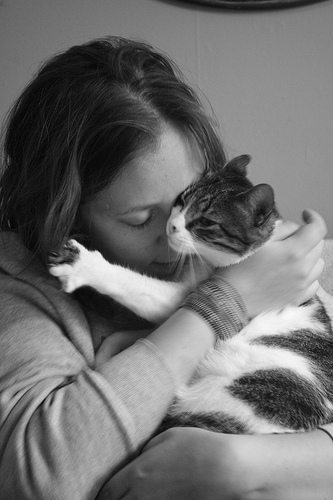Cancer in pets can be difficult to deal with. It was a sad day when I made the decision to put down my beautiful Cameo Persian, who had developed lung cancer. When I learned of her diagnosis, I  thought to myself, “Was she smoking in the laundry room when I wasn’t looking?” and “How could this be?” She was well taken care of and always appeared healthy her entire life, until she turned 18 years of age.
thought to myself, “Was she smoking in the laundry room when I wasn’t looking?” and “How could this be?” She was well taken care of and always appeared healthy her entire life, until she turned 18 years of age.
CHANGES IN BEHAVIOR OR APPEARANCE
Various changes in a pet’s behavior or appearance might indicate the development of cancer. The list below is not always a sign of cancer; however paying attention to such changes and bringing them to the attention of your veterinarian as soon as they occur can increase the chances of successful treatment in the early stages. They include:
• A lump that is changing or growing
• Swollen lymph nodes
• Abdominal swelling
• Unexplained bleeding from the nose, mouth or genital area
• Difficulty breathing, chewing, swallowing, defecating or urinating
• Persistent swelling or sores
• Dry cough
• Recurrent diarrhea or vomiting
• Appetite or weight loss
• Lack of interest in usual activities
• Stiffness or lameness
SPAYING
There are some things pet owners can do to reduce the risk of their pets developing certain types of cancers. One of the most common cancer preventative steps that can be taken is spaying or neutering your pet. For example, female dogs that are spayed before their first heat rarely develop mammary cancer. Those who have not been spayed before their first heat have 200 times greater risk of developing mammary cancer. Research regarding spaying cats before their first heat is not as well-documented as with dogs; however most veterinarians believe the risk of breast cancer in cats is also greatly reduced by spaying.
NUTRITION
Good nutrition and general care can make a big difference in helping your pet live a long and healthy life. Supporting their body nutritionally makes it easier for them to fight cancer and prevent diseases. Look for the best food for your pet that will provide all the nutrients their body needs to function at optimal levels. Read pet food labels carefully for ingredients that may not be all-natural. Ideally, provide fresh, filtered water to your pet every day.
ENVIRONMENT
Reducing known cancer risks in your pet’s environment is another step in preventing cancer for your pet. By controlling your pet’s exposure to sunlight and ultraviolet radiation, you can significantly reduce their risk of skin cancer. The areas on your pet’s body most likely to develop skin cancer are those areas where there is very little fur. These include the eyelids, tip of the nose and ears. For many dogs, the abdomen is also a vulnerable area. Animals with white or fair fur and skin have less natural protection from the sun. Protect your pet especially during the hours of 12 noon and 4 pm by keeping them indoors during these hours, in order to reduce their risk of exposure to ultraviolet radiation. Obviously, normal walks and bathroom breaks pose little risk.
SMOKING
You probably know that second-hand cigarette smoke is just as dangerous to non-smokers as it is to smokers. The same is true for our pets. Tobacco smoke is a leading cause of cancer and is very dangerous, even second-hand. Living in a home with a smoker increases the risk of health problems, including cancer for not only you but your pet as well. Making the decision to quit smoking can lower the chances of anyone in your family developing cancer.
The earlier cancer is detected and diagnosed, the easier it is to treat, and better the outcome may be from treatment. Early treatments offer the best chance for survival and the return to a normal, healthy life. Routine, thorough examination by your veterinarian is the best way to prevent fatal or debilitating cancer in your pet.
Reviewed and Approved by Dr. David L. Roberts, DVM
Photo: Courtesy of Anas Qtiesh via Flickr (CC BY 2.0)









